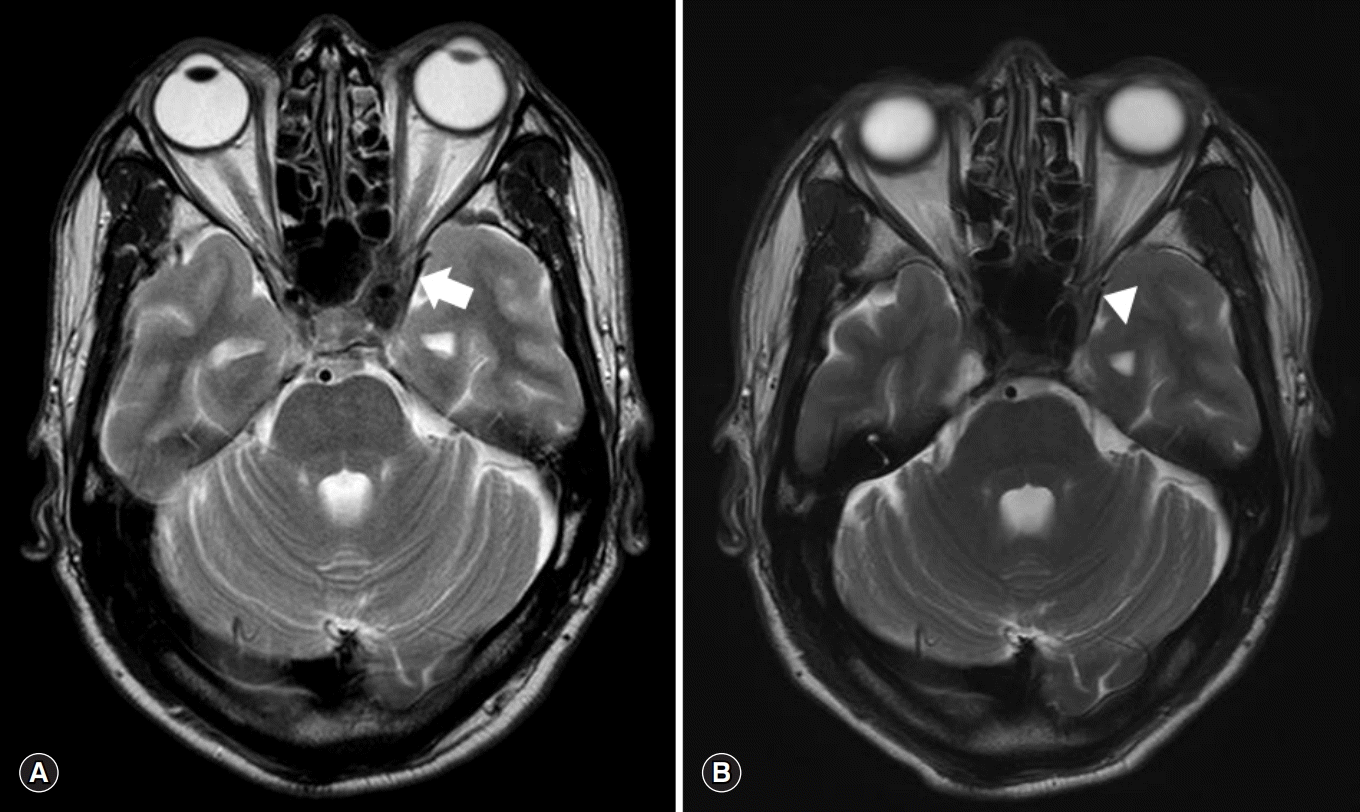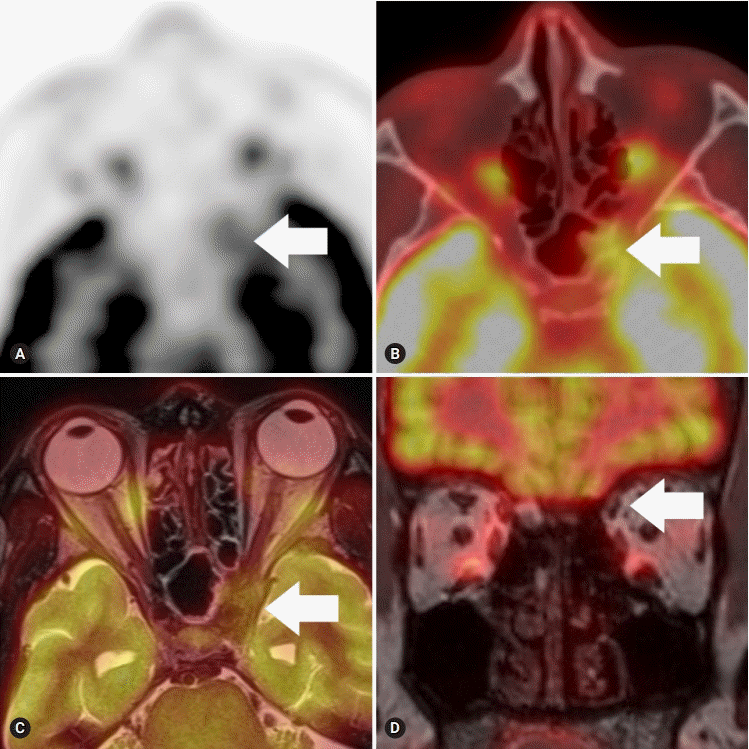This article has been
cited by other articles in ScienceCentral.
Abstract
The most cases with orbital metastases have been reported in patients with a prior established diagnosis of cancer and widespread systemic involvement. However, ocular symptoms can be developed as an initial presentation of cancer in patients without cancer history. We report a case of rapid progression from trochlear nerve palsy to orbital apex syndrome as an initial presentation of advanced gastric cancer.
Go to :

Keywords: Diplopia, Metastasis, Optic neuropathy, Stomach neoplasms, Trochlear nerve palsy
Introduction
The metastasis to the orbit and ocular adnexa is rare and occurs less frequently than metastasis to the eye [
1-
3]. However, the improved survival of patients with common cancers together with the progressive aging of the population has led to a higher incidence of patients living with metastatic disease in unusual sites, such as the orbit and ocular adnexa [
1]. The most cases with orbital metastases have been reported in patients with a prior established diagnosis of cancer and widespread systemic involvement. However, ocular symptoms can be developed as an initial presentation of cancer in patients without cancer history [
3]. We report a case of rapid progression from trochlear nerve palsy to orbital apex syndrome as an initial presentation of advanced gastric cancer.
Go to :

Case
A 56-year-male patient visited the ophthalmic department for vertical diplopia for 1.5 months. The symptom did not have diurnal variation or relation to fatigue. He reported mild painful sensation of the left periocular area. There was no ocular injection, chemosis, moving pain, and visual disturbance. He did not report any other systemic disease. He had no prior history of strabismus or objective diplopia. Visual acuity was 20/20 at both eyes. The pupil showed normal response to both light and near stimulation. He demonstrated 4 prism diopters (PD) hypertropia of the left eye at the primary gaze. The Bielschowsky head tilt test revealed 8 PD of left hypertropia on left tilt and orthotropia on right tilt. The fundus examination showed normal appearance of optic disc and no abnormal torsional finding in both eyes. Acquired isolated trochlear nerve palsy of the left eye was suspected based on the ocular motility findings. Besides the ocular symptoms, he complained of lower back pain since 2 months. The magnetic resonance imaging (MRI) with magnetic resonance angiography of brain, performed at another clinic, revealed no definitive abnormal findings. Serologic tests were conducted to evaluate the cause of diplopia. The initial laboratory results showed the following abnormal values: white blood cell count of 15,750/μL (range, 4,000-10,000/μL), blood urea nitrogen of 32 mg/dL (range, 8-23 mg/dL), alkaline phosphatase (ALP) of 3,828 IU/L (range, 30-120 IU/L), aspartate alanine transferase of 41 IU/L (range, 10-35 IU/L), and alanine aminotransferase of 96 IU/L (range, 0-46 IU/L).
At the follow-up visit 1 week later, he reported that the visual acuity of left eye had suddenly deteriorated to hand motion. The pupil of the left eye showed relative pupillary defect at light stimulation, but fundus had normal appearance. The follow-up MRI demonstrated inhomogeneous enhancement surrounding the optic nerve at the orbital apex through the cavernous sinus of the left eye, which was suspected to have had progressed compared to the previous neuroimaging (
Fig. 1). The computed tomography of the chest and abdomen were performed to evaluate the cause of elevated liver enzymes and ALP and revealed diffuse osteoblastic and osteolytic metastases in visible sections of skeleton, including the thoracolumbar spines, rib cage, and shoulder girdles. The whole body bone scan revealed multiple hot uptake in the skull, whole spines, both scapulas, sternum, both humeri, pelvic bone, and both femurs. The lesion in the orbital apex of the left eye was confirmed by positron emission tomography (
Fig. 2). To locate the primary cancer of bone metastasis, we performed the esophagogastroduodenoscopy (EGD) and colonoscopy. The EGD revealed a 7×5 cm sized ulceroinfiltrating mass from the proximal body to angle of stomach. The biopsy of the mass revealed a signet ring cell carcinoma. He was finally diagnosed with gastric cancer with multiple bone and lymph node metastases.
 | Fig. 1.Axial magnetic resonance imaging of the brain with contrast showing enlargement and enhancement of the left orbital apex (arrow) through the cavernous sinus (A). This lesion (arrow head) was also suspected in previous neuroimaging performed 2 months earlier (B). 
|
 | Fig. 2.Transaxial PET, PET/CT, PET/MRI show a hypermetabolic soft tissue mass (arrows, SUVmax 3.7) extending to the optic canal and superior orbital fissure (A-C). The left superior oblique muscle (arrow) shows asymmetrically decreased physiological uptake, representing denervation injury (D). PET, positron emission tomography; CT, computed tomography; MRI, magnetic resonance imaging; SUVmax, maximum standardized uptake value. 
|
Go to :

Discussion
Most patients with metastatic tumors to the orbit already have a known diagnosis of a primary carcinoma with other evidence of metastases at the time of occurrence of ocular symptoms. However, ocular symptoms can present as the first sign of systemic cancer [
1-
3]. The clinical manifestations of orbital metastasis are variable and include diplopia, proptosis, decreased vision, increased orbital pressure, and limited ocular motility [
1-
3]. Generally, these clinical presentations are unrelenting, have a rapid onset, and entail a disproportionate number of symptoms compared to other space-occupying orbital lesions [
1,
4].
These characteristics are consistent with the ocular findings of our case. Our patient initially developed vertical diplopia caused by trochlear nerve palsy. The visual deterioration of the left eye developed in a short period and was caused by optic neuropathy. The follow-up neuroimaging performed 2 months after the initial examination demonstrated a lesion around the orbital apex through the cavernous sinus which was not suspected definitively in previous study. This rapid progression of ocular symptoms may be attributed to the anatomical location of lesion between the superior orbital fissure, through which the trochlear nerve passes, and the optic canal, through which the optic nerve passes at the orbital apex [
4,
5].
Ipsilateral cranial nerve dysfunction involving a combination of oculomotor nerve, trochlear nerve, trigeminal nerve, abducens nerve, and sympathetic fibers is the hallmark of ophthalmoplegia that is secondary to a cavernous sinuses lesion [
4-
7]. The superior orbital fissure syndrome is often applied to lesions located immediately anterior to the orbital apex, result to cranial nerve palsies absence of optic nerve damage. The orbital apex syndrome has been described as a syndrome involving damage to the multiple cranial nerve with optic nerve dysfunction [
8]. These terms define the precise anatomic location of lesions. However, it is often impossible to distinguish cavernous sinus lesions clinically from those involving the superior orbital fissure. The superior orbital fissure, orbital apex, and cavernous sinus are all contiguous, patients with superior orbital fissure syndrome can subsequently develop orbital apex and cavernous sinus pathology like our case [
8].
Any cancer that can spread via the hematogenous route can metastasize to the orbit and ocular adnexal structures [
1]. Breast cancer has been reported as the most common primary cancer of orbital metastasis in various large studies [
1]. However, recent studies have shown that the most common primary cancer of orbital metastasis is nasopharyngeal carcinoma in southern China and lung cancer in Japan [
2,
3]. These results may be attributed to differences in epidemiology and incidence of the primary cancers. The prognosis for survival in patients with orbital metastasis remains poor. Future advancements in combined treatment modalities may improve quality of life and preserve ocular function. Prompt recognition may help in the detection of an unrecognized primary systemic cancer and allow for early treatment. Yan and Gao reported that orbital metastasis was the first sign of systemic cancer in approximately half of the included patients [
3]. Therefore, ocular examination may have a crucial role in the detection and staging of a previously unsuspected primary cancer. Although orbital metastasis is rare, it should be considered in the differential diagnosis of ocular motility disorder and optic neuropathy.
Go to :







 PDF
PDF Citation
Citation Print
Print



 XML Download
XML Download